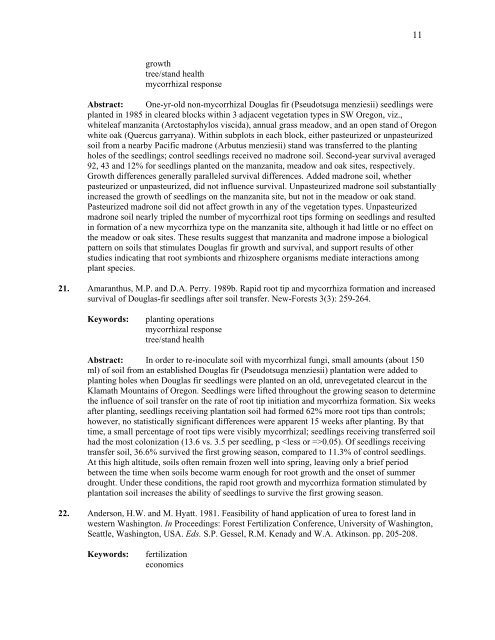IntensIve sIlvIculture - Forest Science Labs - Research Network ...
IntensIve sIlvIculture - Forest Science Labs - Research Network ...
IntensIve sIlvIculture - Forest Science Labs - Research Network ...
You also want an ePaper? Increase the reach of your titles
YUMPU automatically turns print PDFs into web optimized ePapers that Google loves.
growth<br />
tree/stand health<br />
mycorrhizal response<br />
Abstract: One-yr-old non-mycorrhizal Douglas fir (Pseudotsuga menziesii) seedlings were<br />
planted in 1985 in cleared blocks within 3 adjacent vegetation types in SW Oregon, viz.,<br />
whiteleaf manzanita (Arctostaphylos viscida), annual grass meadow, and an open stand of Oregon<br />
white oak (Quercus garryana). Within subplots in each block, either pasteurized or unpasteurized<br />
soil from a nearby Pacific madrone (Arbutus menziesii) stand was transferred to the planting<br />
holes of the seedlings; control seedlings received no madrone soil. Second-year survival averaged<br />
92, 43 and 12% for seedlings planted on the manzanita, meadow and oak sites, respectively.<br />
Growth differences generally paralleled survival differences. Added madrone soil, whether<br />
pasteurized or unpasteurized, did not influence survival. Unpasteurized madrone soil substantially<br />
increased the growth of seedlings on the manzanita site, but not in the meadow or oak stand.<br />
Pasteurized madrone soil did not affect growth in any of the vegetation types. Unpasteurized<br />
madrone soil nearly tripled the number of mycorrhizal root tips forming on seedlings and resulted<br />
in formation of a new mycorrhiza type on the manzanita site, although it had little or no effect on<br />
the meadow or oak sites. These results suggest that manzanita and madrone impose a biological<br />
pattern on soils that stimulates Douglas fir growth and survival, and support results of other<br />
studies indicating that root symbionts and rhizosphere organisms mediate interactions among<br />
plant species.<br />
21. Amaranthus, M.P. and D.A. Perry. 1989b. Rapid root tip and mycorrhiza formation and increased<br />
survival of Douglas-fir seedlings after soil transfer. New-<strong>Forest</strong>s 3(3): 259-264.<br />
Keywords: planting operations<br />
mycorrhizal response<br />
tree/stand health<br />
Abstract: In order to re-inoculate soil with mycorrhizal fungi, small amounts (about 150<br />
ml) of soil from an established Douglas fir (Pseudotsuga menziesii) plantation were added to<br />
planting holes when Douglas fir seedlings were planted on an old, unrevegetated clearcut in the<br />
Klamath Mountains of Oregon. Seedlings were lifted throughout the growing season to determine<br />
the influence of soil transfer on the rate of root tip initiation and mycorrhiza formation. Six weeks<br />
after planting, seedlings receiving plantation soil had formed 62% more root tips than controls;<br />
however, no statistically significant differences were apparent 15 weeks after planting. By that<br />
time, a small percentage of root tips were visibly mycorrhizal; seedlings receiving transferred soil<br />
had the most colonization (13.6 vs. 3.5 per seedling, p 0.05). Of seedlings receiving<br />
transfer soil, 36.6% survived the first growing season, compared to 11.3% of control seedlings.<br />
At this high altitude, soils often remain frozen well into spring, leaving only a brief period<br />
between the time when soils become warm enough for root growth and the onset of summer<br />
drought. Under these conditions, the rapid root growth and mycorrhiza formation stimulated by<br />
plantation soil increases the ability of seedlings to survive the first growing season.<br />
22. Anderson, H.W. and M. Hyatt. 1981. Feasibility of hand application of urea to forest land in<br />
western Washington. In Proceedings: <strong>Forest</strong> Fertilization Conference, University of Washington,<br />
Seattle, Washington, USA. Eds. S.P. Gessel, R.M. Kenady and W.A. Atkinson. pp. 205-208.<br />
Keywords: fertilization<br />
economics<br />
11
















